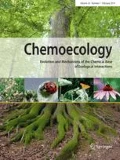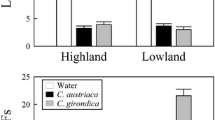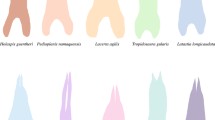Summary
Strike-induced chemosensory searching (SICS) is experimentally demonstrated in a teiid lizard,Tupinambis nigropunctatus. SICS consists of a concurrent post-strike elevation in tongue-flick rate (PETF) and searching movements after voluntary release or escape of bitten prey or removal of prey from the predator's mouth. The results are consistent with previous data showing that PETF and/or SICS occur in all families of scleroglossan lizards and snakes and all families of actively foraging lizards yet studied. The relatively short duration of SICS (2 min) in a lizard having lingual and vomeronasal structure highly specialized for chemosensory sampling and analysis suggests that phylogenetic and ecological factors may be more important than morphology in determining the duration. The greatest known durations occur only in the presumably monophyletic clade containing varanoid lizards and snakes, all of which have highly developed chemical sampling and chemoreceptor apparatus, but in addition feed on prey that has a high probability of being relocated by prolonged scent-trailing. Because only active foragers move through the habitat while tongue-flicking and exhibit lingually mediated prey chemical discrimination, only active foragers may be expected to use SICS. SICS would appear to be useless to an ambush forager and might disrupt its defensive crypticity, rendering it more detectable to predators and prey. Therefore, it may be predicted that SICS is adaptively adjusted to foraging mode.
Similar content being viewed by others
References
Anderson RA (1993) Analysis of foraging in a lizard,Cnemidophorus tigris: silent features and environmental effects. Pp 83–116in Wright JW, Vitt LJ (eds) Biology of Whiptail Lizards (GenusCnemidophorus). Norman, Oklahoma: Oklahoma Museum of Natural History
Auffenberg W (1981) The Behavioral Ecology of the Komodo Monitor. Gainesville FL: University Press of Florida
Beck DD (1990) Ecology and behavior of the gila monster in southwestern Utah. J Herpetol 25:395–406
Bogert CM, Del Campo RM (1956) The gila monster and its allies: the relationships, habits, and behavior of the lizards of the family Helodermatidae. Bull Amer Mus Nat Hist 109:1–238
Burghardt GM (1993) Strike-induced chemosensory searching by ingestively naive garter snakes (Thamnophis sirtalis). J Comp Psychol 107:116–121
Chiszar D, Scudder KM (1980) Chemosensory searching by rattlesnakes during predatory episodes. Pp 125–139in Müller-Schwarze D, Silverstein RM (eds) Chemical Signals: Vertebrates and Aquatic Invertebrates. New York: Plenum Press
Chiszar D, Radcliffe CW, O'Connell B, Smith HM (1982) Analysis of the behavioral sequence emitted by rattlesnakes during predatory episodes. II. Duration of strike-induced chemosensory searching in rattlesnakes (Crotalus viridis, C. enyo). Behav Neural Biol 34:261–270
Chiszar D, Radcliffe CW, Overstreet R, Poole T, Byers Y (1985) Duration of strike-induced chemosensory searching in cotton-mouths (Agkistrodon piscivorus) and a test of the hypothesis that striking creates a specific search image. Can J Zool 63:1057–1061
Cooper WE Jr (1989a) Strike-induced chemosensory searching occurs in lizards. J Chem Ecol 15:1311–1320
Cooper WE Jr (1989b) Absence of prey odor discrimination by iguanid and agamid lizards in applicator tests. Copeia 1989:472–478
Cooper WE Jr (1990a) Prey odour discrimination by lizards and snakes. Pp 533–538in Macdonald DW, Müller-Schwarze D, Natynczuk SE (eds) Chemical Signals in Vertebrates V. GB-Oxford: Oxford University Press
Cooper WE Jr (1990b) Prey odor detection by teiid and lacertid lizards and the relationship of prey odor detection to foraging mode in lizard families. Copeia 1990:237–242
Cooper WE Jr (1991a) Responses to prey chemicals by a lacertid lizard,Podarcis muralis: prey chemical discrimination and post-strike elevation in tongue-flick rate. J Chem Ecol 17:849–863
Cooper WE Jr (1991b) Discrimination of integumentary prey chemicals and strike-induced chemosensory searching in the ball python,Python regius. J Ethol 9:9–23
Cooper WE Jr (1992a) Elevation in tongue-flick rate after biting prey in the broad-headed skink,Eumeces laticeps. J Chem Ecol 18:455–467
Cooper WE Jr (1992b) Prey odor discrimination and poststrike elevation in tongue-flicking by a cordylid lizard,Gerrhosaurus nigrolineatus. Copeia 1992:146–154
Cooper WE Jr (1992c) Post-bite elevation in tongue-flick rate by neonatal garter snakes. Ethology 91:339–345
Cooper WE Jr (1993) Duration of poststrike elevation in tongue-flicking rate in the savannah monitor lizard,Varanus exanthematicus. Ecol Ethol Evol 5:1–18
Cooper WE Jr (1994a) Prey chemical discrimination, foraging mode, and phylogeny.In Planka ER, Vitt LJ (eds) Lizard Ecology: the Third Generation. Princeton/NJ: Princeton University Press
Cooper WE Jr (1994b) Multiple functions of extraoral lingual behavior in iguanian lizards: prey capture, grooming, and swallowing, but not prey detection. Anim Behav: in press
Cooper WE Jr, Alberts AC (1990) Responses to chemical food stimuli by an herbivorous actively foraging lizard,Dipsosaurus dorsalis. Herpetologica 46:259–266
Cooper WE Jr, Alberts AC (1993) Post-bite elevation in tongue-flicking rate by an iguanian lizard,Dipsosaurus dorsalis. J Chem Ecol 19:2329–2336.
Cooper WE Jr, Arnett, J (1994) Strike-induced chemosensory searching in the gila monster. Manuscript in review
Cooper WE Jr, Burghardt GM (1990) Vomerolfaction and vomodor. J Chem Ecol 16:103–105
Cooper WE Jr, Vitt LJ (1986) Thermal dependence of tongue-flicking and comments on use of tongue-flicking as an index of squamate behavior. Ethology 71:177–186
Cooper WE Jr, McDowell SG, Ruffer J (1989) Strike-induced chemosensory searching in the colubrid snakesElaphe g. guttata andThamnophis sirtalis. Ethology 81:19–28
DeFazio A, Simon CA, Middendorf GA, Romano D (1977) Substrate licking in an iguanid lizard: a response to novel situations inSceloporus jarrovi. Copeia 1977:706–709
Estes R, De Queiroz K, Gauthier J (1988) Phylogenetic relationships within Squamata. Pp 119–281in Estes R, Pregill G (eds) Phylogenetic Relationships of the Lizard Families. Stanford/CA: Stanford University Press
Gabe M, Saint Girons H (1976) Contribution a la morphologie comparée des fosses nasales et de leur annexes chez les lépidosauriens. Mem Mus National d'Hist Nauterelle (Nouvelle Series) 98 Serie A:1–87
Graves BM, Halpern M (1989) Chemical access to the vomeronasal organs of the lizardChalcides ocellatus. J Exp Zool 249:150–157
Halpern M (1992) Nasal chemical senses in reptiles: structure and function. Pp 423–523in Gans C, Crews D (eds) Biology of the Reptilia. Vol. 18, Brain, Hormones, and Behavior. Chicago/IL: University of Chicago Press
Iverson JB (1982) Adaptations to herbivory in iguanine lizards. Pp. 60–76in Burghardt GM, Rand AS (eds) Iguanas of the World: Their Behavior, Ecology, and Conservation. Park Ridge/NJ: Noyes Publ
McDowell SB (1972) The evolution of the tongue in snakes, and its bearing on snake origins. Pp 191–273in Dobzhansky T, Hecht MK, Steere WC (eds) Evolutionary Biology. Vol. 6. New York/NY: Appleton-Century-Crofts
Radcliffe CW, Chiszar D, O'Connell B (1980) Effects of prey size on poststrike behavior in rattlesnakes (Crotalus durissus, C. enyo, andC. viridis). Bull Psychon Sci 16:449–450
Schwenk K (1988) Comparative morphology of the lepidosaur tongue and its relevance to squamate phylogeny. Pp 569–598in Estes R, Pregill G (eds) Phylogenetic relationships of the lizard families. Stanford/CA: Stanford University Press
Siegel S (1956) Nonparametric Statistics for the Behavioral Sciences. New York/NY: McGraw-Hill
Van Damme R, Bauwens D, Vanderstighelen D, Verheyen RF (1990) Responses of the lizardLacerta vivipara to predator chemical cues: the effects of temperature. Anim Behav 40:298–305
Vitt LJ, Price H (1982): Ecological and evolutionary determinants of relative clutch mass in lizards. Herpetologica 38:237–255
Walls GY (1981) Feeding ecology of the tuatara (Sphenodon punctatus) on Stephens Island, Cook Strait. New Zeal J Ecol 4:89–97
Walls GY (1983) Activity of the tuatara and its relationships to weather conditions on Stephens Island, Cook Strait, with observations on geckos and invertebrates. New Zeal J Zool 10:309–318
Winer BJ (1962) Statistical Principles in Experimental Design. New York/NY: McGraw-Hill
Author information
Authors and Affiliations
Rights and permissions
About this article
Cite this article
Cooper, W.E. Strike-induced chemosensory searching by a teiid lizard, the golden tegu (Tupinambis nigropunctatus). Chemoecology 4, 79–85 (1993). https://doi.org/10.1007/BF01241677
Issue Date:
DOI: https://doi.org/10.1007/BF01241677




